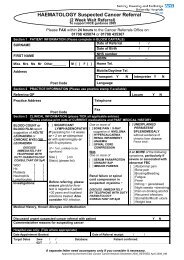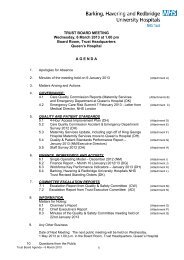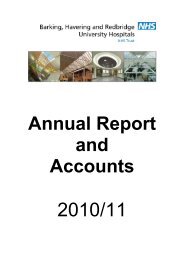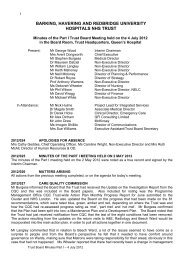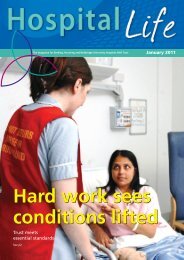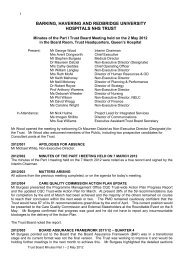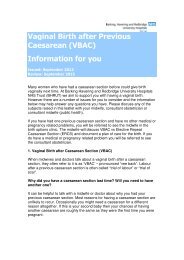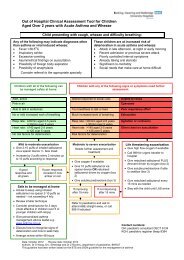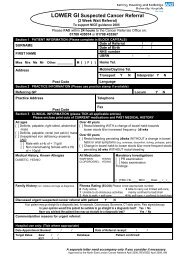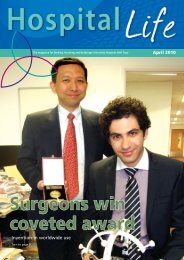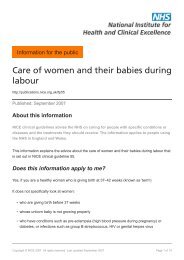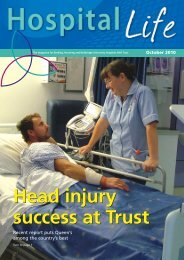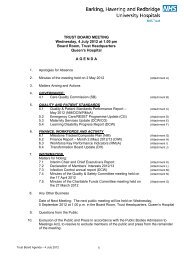Trust Board papers November 2012 - Barking Havering and ...
Trust Board papers November 2012 - Barking Havering and ...
Trust Board papers November 2012 - Barking Havering and ...
You also want an ePaper? Increase the reach of your titles
YUMPU automatically turns print PDFs into web optimized ePapers that Google loves.
turnover increased by 0.34% to 11.57% -<br />
despite the increase this remains 0.43% below<br />
the current average of other large Acute <strong>Trust</strong>s.<br />
• The reported sickness absence rate for the<br />
month of September has decreased slightly by<br />
0.13% on the August position, reducing from<br />
4.68% to 4.55% across the month. The sickness<br />
absence rate has decreased by 0.25% when<br />
compared to the same period last year.<br />
• The pan London benchmarking exercise against<br />
other acute Large London <strong>Trust</strong>s has been<br />
repeated which shows that the combined<br />
average sickness absence rate for this group is<br />
3.59% - as such the graph has been revised to<br />
reflect this. Based upon this revised information<br />
BHRUT's benchmarked position shows us as<br />
currently sitting 0.94% above the 3.59% average<br />
of all other large acute London <strong>Trust</strong>s. The<br />
<strong>Trust</strong>'s target remains at 3.6%<br />
• Part of the increase in reported sickness<br />
absence rates is related to improve recording<br />
through the roll out of electronic systems such as<br />
e-rostering. This has minimised the effort in<br />
recording <strong>and</strong> reporting of all types of staff<br />
absence, including sickness through<br />
managers/supervisors especially in the clinical<br />
areas no longer having to complete <strong>and</strong> submit<br />
weekly absence returns.<br />
• It is acknowledged that key to achieving a<br />
significant reduction in rates is: reviewing &<br />
updating our existing sickness absence policy,<br />
sickness absence management training <strong>and</strong><br />
working with proactively managers to underst<strong>and</strong><br />
the support they require to manage sickness<br />
absence.<br />
• These actions have been initiated <strong>and</strong> additional<br />
schemes such as staff MOT days continue in<br />
order to encourage staff to proactively manage<br />
their own health & wellbeing at work.<br />
• Occupational Health have implemented monthly<br />
case meetings with Directorates to discuss the<br />
management <strong>and</strong> progress of individual cases<br />
• The estimated costs associated with sickness<br />
absence have increased this month. It is<br />
estimated that the cost to the <strong>Trust</strong> for<br />
September was £878,995. This figure has risen<br />
by an estimated £259,997 on the same period<br />
last year despite the sickness rate reducing by<br />
0.25%. The rise in the estimated costs of<br />
sickness absence is attributed to the b<strong>and</strong>ing<br />
<strong>and</strong> roles of those staff taking sick absence<br />
compared to the same period last year, the<br />
higher the b<strong>and</strong> or more senior the role the<br />
higher the associated cost.<br />
• When the number of FTE's lost due to sickness<br />
absence is analysed by reason for absence, the<br />
highest loss remains 'Unknown causes - not<br />
specified' with 39.40 fte lost.<br />
• To counteract this as previously presented to the<br />
<strong>Trust</strong> <strong>Board</strong>, the <strong>Trust</strong> as part of their contract<br />
review <strong>and</strong> renewal process with McKesson<br />
have requested that this reason be removed<br />
from the reporting options. Therefore 'unknown<br />
2



![[4] Biopsy Leaflet.pub - Barking, Havering and Redbridge University ...](https://img.yumpu.com/51285530/1/190x134/4-biopsy-leafletpub-barking-havering-and-redbridge-university-.jpg?quality=85)

